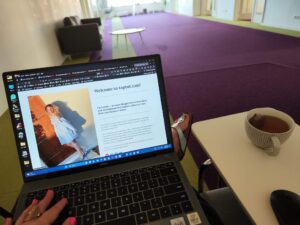Ever feel like your home office is working against your productivity?
Between the clutter, tangled wires, and general sense of chaos, it can be tough to focus, let alone feel inspired. For entrepreneurs with ADD, busy solopreneurs, content creators facing deadlines, or anyone wanting a more streamlined work life, this struggle is all too familiar. That’s where the magic of minimalist design comes in.
Minimalism, grounded in the “less is more” philosophy—an idea present in everything from ancient Zen principles to modern architecture—isn’t just about aesthetics. It’s about being intentional with your space. By removing the unnecessary, you make room for what truly matters: focus, creativity, and flow. Think of it as decluttering your physical space, just like you would your digital files. This approach is incredibly valuable in our busy, interconnected world. A minimalist home office isn’t just a passing trend; it’s a real strategy for a better work life.
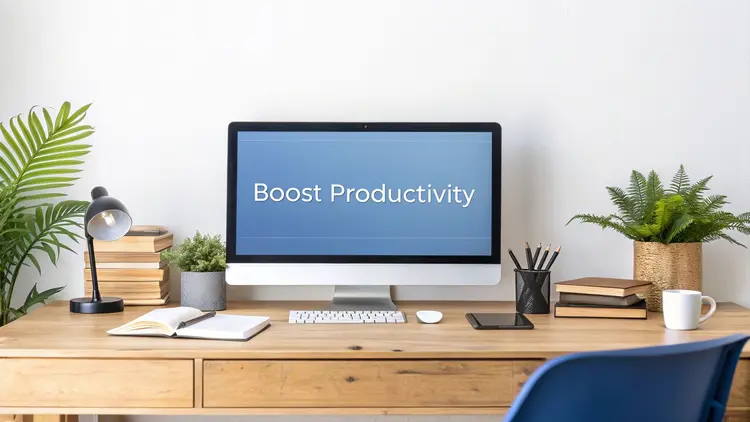
An effective minimalist workspace prioritizes functionality and eliminates distractions, creating an environment where you can truly thrive. It’s about designing a sanctuary for your mind, a place where new ideas can blossom and productivity can soar. In this article, we’ll explore eight key strategies to help you transform your home office into a minimalist haven. We’ll cover everything from optimizing your layout and embracing clever storage solutions to incorporating natural elements and taming that inevitable cable chaos. Get ready to discover how simple changes can make a world of difference in your work life!
1. Floating Desk Setup
For entrepreneurs juggling multiple tasks, solopreneurs craving a clean workspace, or content creators looking for a minimalist solution, the floating desk offers a sleek answer to limited space. This wall-mounted piece is more than just trendy furniture; it’s a productivity booster disguised as elegant design. Removing the visual clutter of desk legs creates the illusion of a larger workspace, allowing your mind to focus on the task at hand.
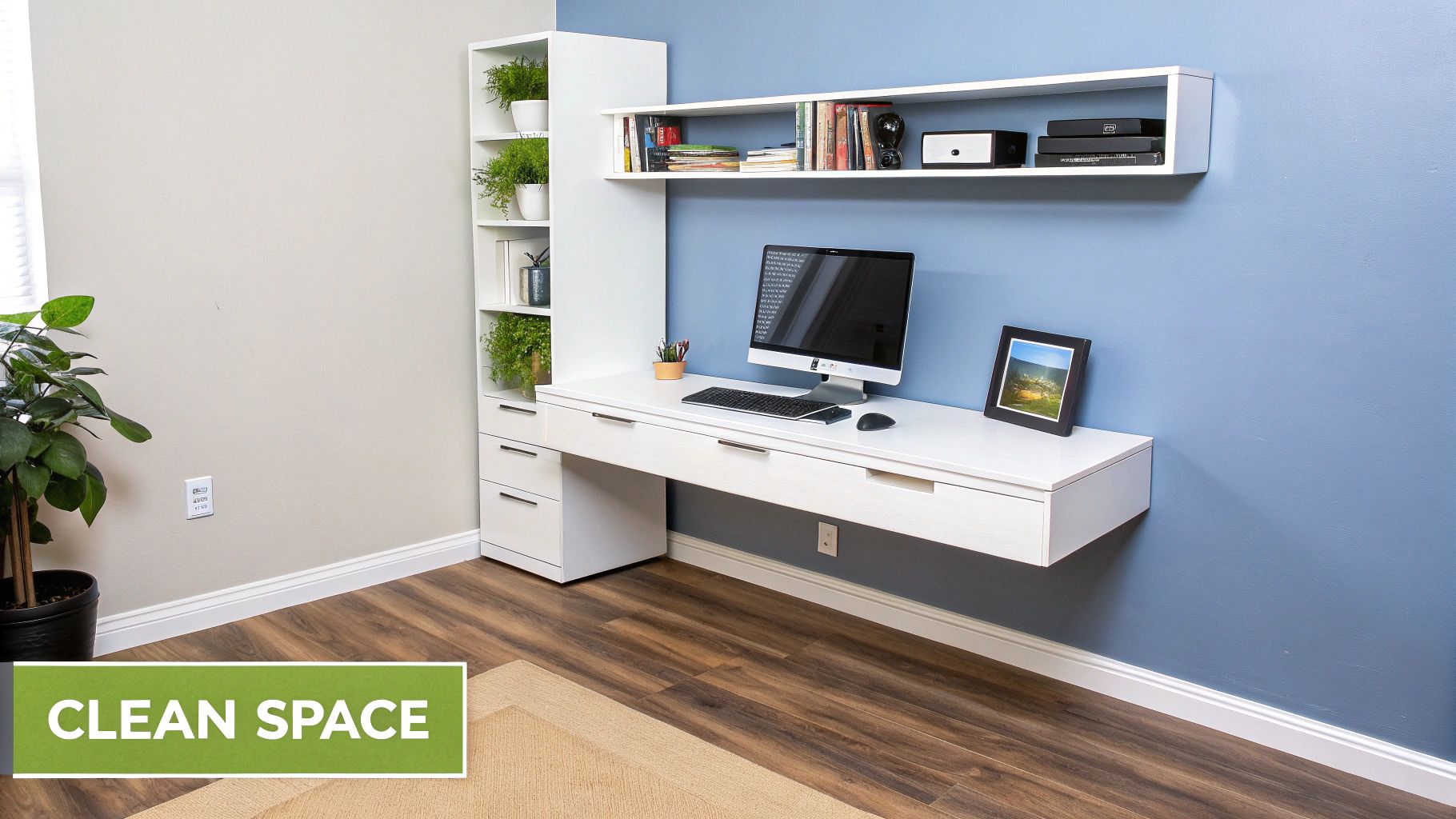
Typically ranging from 30-48 inches in width, these desks can be installed at custom heights, adapting to your needs and room dimensions. Whether made from solid wood, engineered wood, or laminate materials, a floating desk contributes to a clean aesthetic. This makes it perfect for minimalist home offices, appealing to those seeking a streamlined workspace.
Why a Floating Desk Deserves a Spot in Your Minimalist Arsenal:
- Maximizes Space: The biggest advantage is the illusion of spaciousness. Keeping the floor clear makes a room appear larger, which is crucial for small apartments or shared workspaces.
- Easy Cleanliness: Forget about dust bunnies under the desk! Cleaning becomes simple with the floor fully accessible.
- Versatile Placement: Alcoves, awkward corners, small bedrooms – a floating desk can transform unusable areas into productive work zones.
- Budget-Friendly: Basic floating desk models are often cheaper than traditional desks with similar surface areas.
Weighing the Pros and Cons:
| Pros | Cons |
|---|---|
| Creates an illusion of more space | Limited weight capacity compared to traditional desks |
| Easy to clean underneath | Requires wall mounting (potentially challenging for renters) |
| Can be installed in unusable spaces | Usually offers minimal or no built-in storage |
| Often less expensive than full desks | Not easily relocated once installed |
| Adaptable to any room size | May require professional installation for proper support |
Real-World Inspiration and DIY Solutions:
From IKEA’s BJUROXER shelf repurposed as a minimalist desk to custom creations by Etsy artisans, the floating desk is popular. CB2’s Go-Cart White Rolling Desk, with its wall-mount option, offers a hybrid solution for those seeking flexibility. Even Floyd’s The Table can be adapted into a wall-mounted workspace. This popularity is linked to the rise of minimalist philosophies like Marie Kondo’s decluttering methods and IKEA’s focus on space-saving furniture, as well as features in publications like Architectural Digest showcasing small-space living. The aesthetic is also all over social media platforms like Pinterest and Instagram, inspiring countless minimalist home office setups.
Tips for Seamless Implementation:
- Secure Mounting: Ensure you hit wall studs or use appropriate anchors to support the desk and your equipment.
- Ergonomic Height: Install the desk at standard desk height (29-30 inches) for proper posture.
- Cable Management: Conceal cords and cables using cable management solutions to preserve the clean look.
- Added Storage: Install small floating shelves above the desk for additional storage and organization. You might be interested in Our guide on Home Office Organization Tips.
- Comfortable Depth: Opt for a desk depth of at least 20 inches to accommodate a computer, keyboard, and mouse comfortably.
2. Monochromatic Color Scheme
A minimalist home office is all about simplicity and focus. One of the best ways to achieve this zen-like atmosphere is with a monochromatic color scheme. This design approach uses variations of a single color to create a cohesive and visually calming workspace. Imagine a workspace free of clashing colors, where your eyes can relax and your mind can truly focus. That’s the magic of a monochromatic setup.
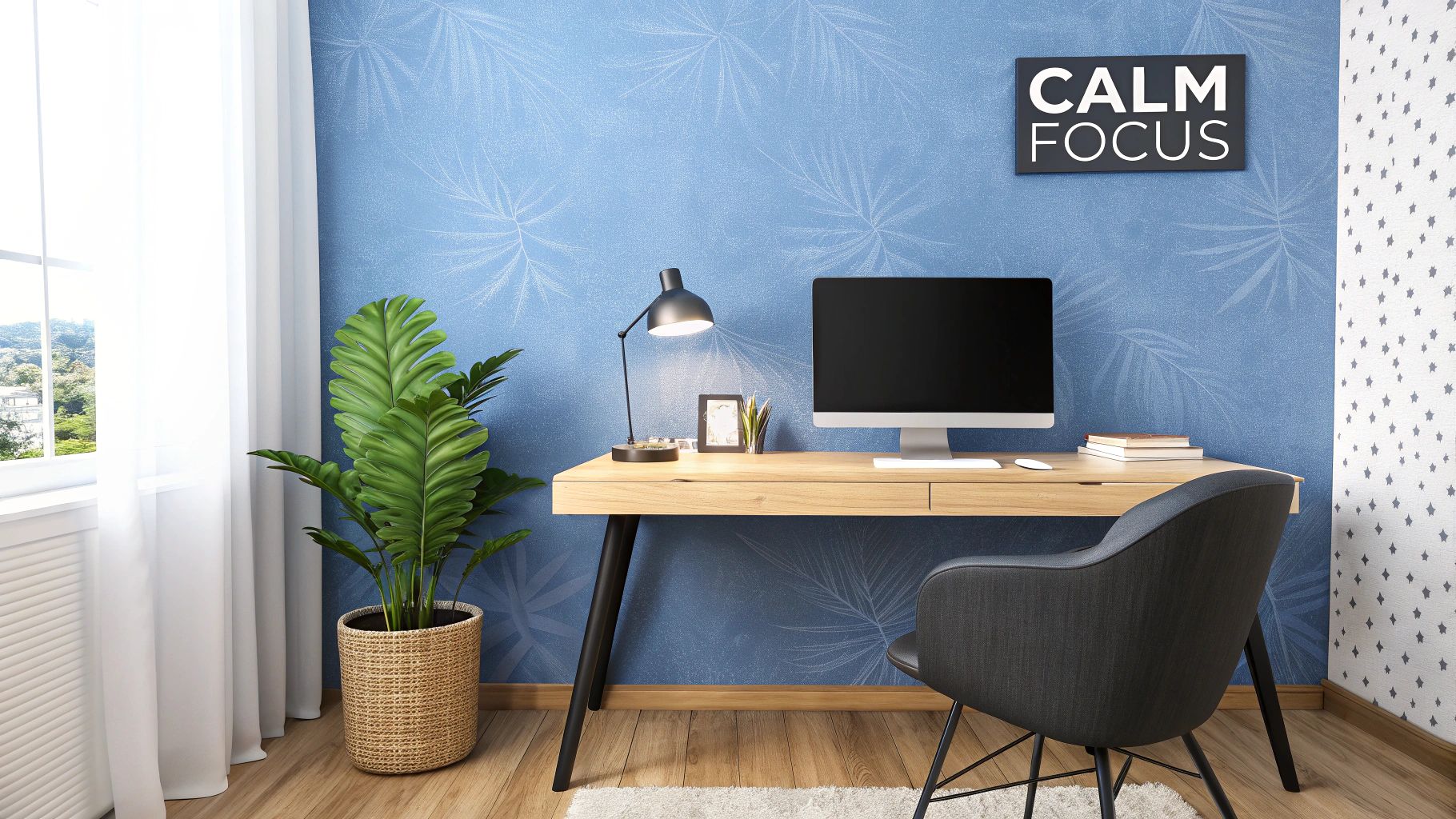
This strategy streamlines design decisions—no more stressing over which colors go together! It also creates a sophisticated, modern aesthetic that aligns perfectly with minimalist principles. Think clean lines, uncluttered surfaces, and a feeling of spaciousness, even in a smaller room. This typically involves using neutral colors like white, gray, beige, or black as your base. Then, you can incorporate various shades and tones of that color to add depth and visual interest.
Texture plays a crucial role in a monochromatic scheme. Using materials like wood, metal, fabric, and glass prevents the space from feeling flat or one-dimensional. Adding plants brings a touch of life and offers subtle contrast within your chosen color palette.
Benefits of a Monochromatic Color Scheme
This approach isn’t just about aesthetics; it offers practical advantages, too. Here’s a breakdown of the pros and cons:
Pros:
- Creates visual cohesion and harmony: This leads to a sense of calm and order.
- Reduces decision fatigue: Simplifying the design process.
- Makes small spaces appear larger: Light, consistent colors make a room feel more open.
- Easy to maintain and update: No need to constantly re-evaluate color combinations.
- Promotes focus: By minimizing visual distractions.
Cons:
- Can feel cold or sterile: This can be mitigated with warm textures and lighting.
- May become visually boring: If texture variation is lacking.
- Less opportunity for personal expression through color: This might be a drawback for some.
- Can be challenging to differentiate functional areas: Requires thoughtful organization.
- Requires careful lighting consideration: To avoid a flat appearance.
Inspiration and Modern Examples
The monochromatic aesthetic has a rich history, with roots in minimalist designers like John Pawson, Japanese aesthetic philosophies, and Scandinavian design principles. Modern tech companies like Apple, with its iconic white product designs, have also popularized the look. You can find further inspiration in Muji’s minimalist collections and publications like Kinfolk and Dwell magazines. You might also be interested in: Our guide on the Secret of Colors in the Office.
Tips for Implementing a Monochromatic Color Scheme
- Add texture: Incorporate materials like wood, metal, fabric, and glass.
- Incorporate plants: Introduce a touch of natural color and life.
- Use lighting strategically: Create depth and dimension with layered lighting.
- Choose furniture with interesting silhouettes: Add visual interest without relying on color.
- Include subtle pattern variations: Prevent monotony within your chosen color palette.
For entrepreneurs, solopreneurs, content creators, and anyone seeking a productive and calming workspace, a monochromatic color scheme is a game-changer. Minimizing distractions and promoting a sense of order helps you focus on what truly matters: your work.
3. Multi-Functional Furniture Solutions
Multi-functional furniture is a game-changer for entrepreneurs juggling multiple projects, solopreneurs with a lot on their plate, or minimalists seeking a clutter-free sanctuary. It’s the embodiment of “less is more” for a home office, maximizing functionality without sacrificing precious space. Instead of individual pieces for each task, these ingenious solutions combine storage, work surfaces, and sometimes even seating into cohesive units. This streamlines your workspace and fosters a sense of calm and focus, especially beneficial for those prone to distraction.
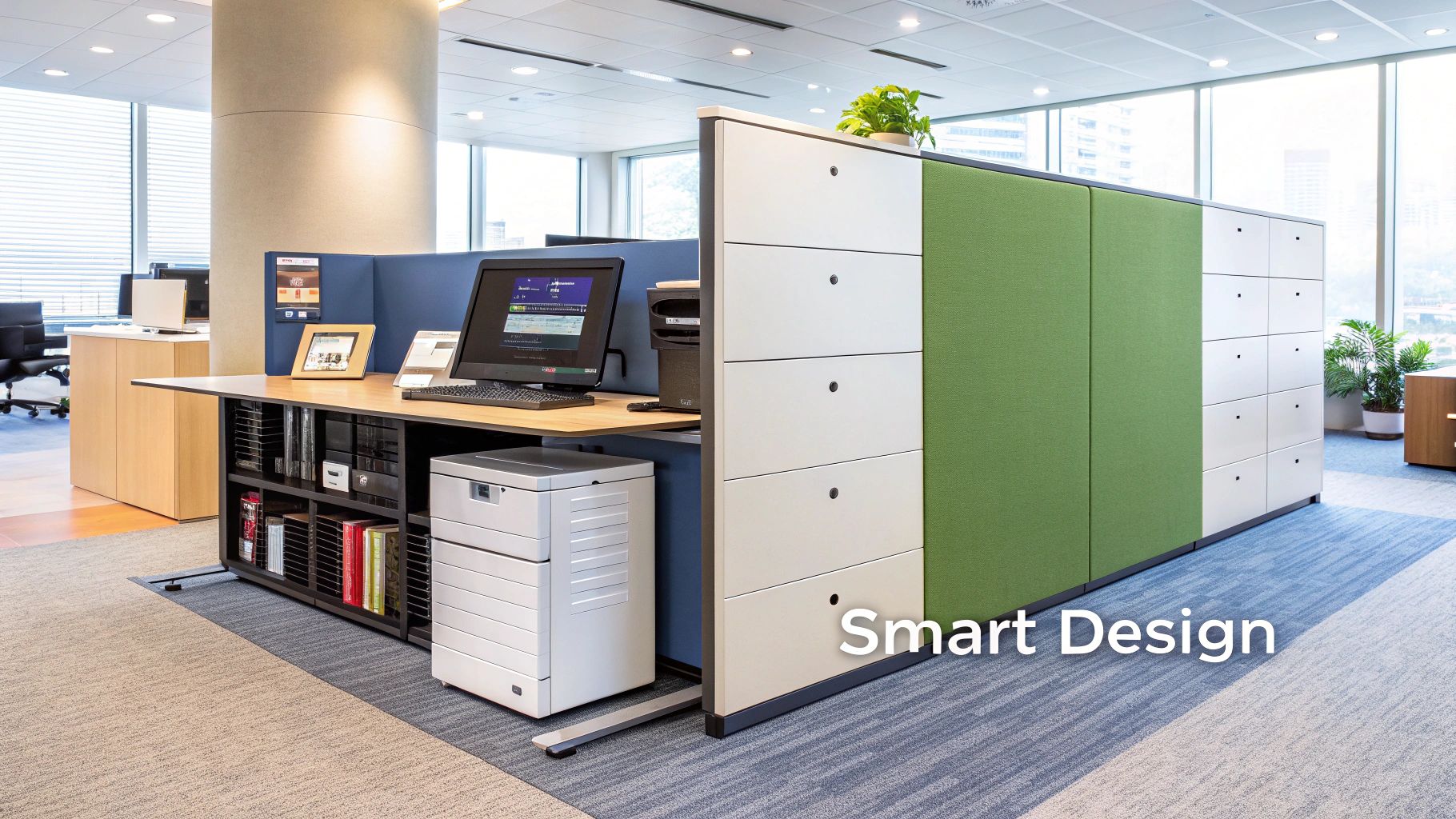
Think desks with hidden compartments for your laptop and stationery, fold-away workspaces that vanish when not in use, or modular shelving units that adapt to your evolving needs. These aren’t just space-saving hacks; they’re productivity boosters. A clean, organized environment translates to a clear, organized mind.
Features That Make a Difference
- Integrated Storage: Say goodbye to messy piles of paperwork and cluttered desktops. Built-in drawers, shelves, and compartments keep everything neatly tucked away.
- Convertible Designs: Need a desk for focused work and a table for brainstorming? Transformable furniture lets you switch between modes effortlessly.
- Compact Footprints: Maximize limited space with designs optimized for smaller areas.
- Hidden Cable Management: Keep unsightly cords and cables out of sight for a clean, uncluttered look.
Pros and Cons of Multi-Functional Furniture
Here’s a quick rundown of the advantages and disadvantages:
| Pros | Cons |
|---|---|
| Maximizes functionality in limited space | Can be more expensive than single-purpose furniture |
| Reduces the total number of furniture pieces | May involve some ergonomic compromises |
| Creates a cleaner, more visually appealing workspace | Often heavier and more difficult to move |
| Often includes smart storage solutions | Can be complex to assemble |
| Enables easy transition between work and personal time | May not excel at any single function compared to a dedicated piece |
Real-World Examples
- BDI Sequel Lift Desk: Combines a sleek work surface with integrated storage and cable management. (BDI Furniture)
- Resource Furniture’s Transformable Desk Systems: Offers ingenious solutions like wall-mounted desks that fold away when not in use. (Resource Furniture)
- IKEA MICKE Workstation: A budget-friendly option with integrated storage and a compact design. (IKEA)
Tips for Implementation
- Prioritize Ergonomics: Ensure the primary function (e.g., desk height for typing) is ergonomically sound.
- Conceal Technology: Choose furniture that effectively hides cables and electronics.
- Invest in Quality: Look for durable construction that can withstand frequent use and transformation.
- Consider Your Workflow: Think about all your activities before selecting a piece.
- Test Transformable Elements: Make sure they operate smoothly and easily.
The Rise of Multi-Functional Furniture
The popularity of multi-functional furniture has soared, fueled by trends like the tiny house movement, Japanese small-space design philosophies, and the rise of remote work. Innovative furniture designers, especially Italian designers, have also contributed to this rise. Resource Furniture, for instance, has become a leading name in space-maximizing solutions.
For anyone striving for a minimalist, productive home office, multi-functional furniture deserves a prominent place in your setup. It’s a smart investment that will enhance your workspace and contribute to a more focused and organized lifestyle. Whether you’re meticulously planning your day or seeking a streamlined workflow, embracing multi-functional furniture is a step towards a simpler, more effective work environment.
4. Digital Decluttering System
A minimalist home office isn’t just about your physical space; it’s about mental space, too. A cluttered digital environment can feel just as distracting and overwhelming as a physical one. That’s where a digital decluttering system comes in. It’s your key to taming the digital beast, creating a minimalist approach to managing your files, apps, and workflows.
This system will help you reduce the virtual clutter that can bleed into your physical world. It includes several key aspects:
- Streamlined file naming and organization conventions
- Cloud-based storage like OneDrive to free up your local hard drive
- Paperless workflow processes
- Minimalist desktop and application interfaces
- Scheduled digital cleanup routines
Think of it as Marie Kondo for your computer!
Benefits of a Digital Decluttering System
The benefits of a digital decluttering system are numerous:
- Reduced need for physical storage and paper: Go green and save space!
- Improved focus: Minimize digital distractions and get more done.
- Simplified file retrieval: No more endless searching!
- Support for remote work: Access your files from anywhere.
- Visual calm: Enjoy a clean, organized desktop.
Imagine opening your laptop to a clean, organized desktop instead of a chaotic jumble of icons. That’s the power of a digital decluttering system.
For example, imagine a content creator constantly struggling to locate images for their blog posts, wasting precious time sifting through disorganized folders. By implementing a consistent file naming convention (e.g., date-project-version) and utilizing cloud storage, they can quickly find the assets they need, streamlining their workflow and boosting productivity. Want to learn more? Check out our guide on setting up a digital file organization system.
Considerations and Drawbacks
Of course, no system is perfect. Here are a few things to keep in mind:
- Initial time investment: Setting up the system takes time.
- Ongoing maintenance: Staying organized requires effort.
- Cost of cloud storage: Subscription services can add up.
- Security concerns: Data breaches are a valid concern.
- Potential inflexibility: Highly structured systems can sometimes feel less flexible for complex workflows.
Inspiration and Tools
Several popular tools and philosophies have helped bring digital decluttering into the mainstream. Cal Newport’s “Digital Minimalism” philosophy advocates for intentional technology use, while Marie Kondo’s “Joy at Work” methods can be applied to digital spaces. Greg McKeown’s “Essentialism” encourages us to focus on the vital few digital tools and processes. Even Apple’s minimalist design philosophy has played a role.
Practical Tips to Get Started
Here are a few practical tips to help you get started with digital decluttering:
- Consistent file naming: Use a date-project-version format.
- Regular decluttering sessions: Schedule weekly 15-minute sessions.
- Text expansion tools: Reduce repetitive typing.
- Remove unused applications: Keep only what you need.
- Automate software updates: Stay current with less effort.
- Create templates: Streamline recurring tasks.
- Virtual desktops: Separate different work modes.
Tools like Notion, Evernote, a clean macOS interface, OneDrive with SharePoint integration, and Google’s suite of collaborative tools are excellent examples of resources you can use to create a streamlined digital workspace.
This makes it a critical element for any minimalist home office, especially for entrepreneurs, productivity seekers, solo business owners, content creators, and anyone striving for a more focused and efficient work life.
5. Cable Management Solutions: Taming the Wire Jungle for a Zen Workspace
A truly minimalist home office means more than just a clean desk. It also means getting those unruly cables under control! Good cable management is essential for a functional and productive workspace, especially for entrepreneurs with ADD or anyone who thrives in a clutter-free environment. It’s all about intentional design – making sure everything in your office has a purpose and contributes to a calm and focused atmosphere. A tangled mess of wires is distracting, collects dust, and can even be a tripping hazard – all things that hinder a smooth and efficient workflow.
Cable management involves using different techniques and tools to organize and hide those inevitable wires that come with our tech. These solutions range from simple DIY tricks to more advanced integrated systems. Think cable clips, sleeves, and ties for bundling wires, under-desk cable trays and raceways to hide larger bundles, and even built-in desk grommets and pass-throughs for a truly seamless look.
Why Cable Management Matters
- Visual Clarity = Mental Clarity: A clean, organized workspace brings a sense of calm and control, especially beneficial for those with ADD or anyone easily distracted by visual clutter. This visual neatness is a cornerstone of the minimalist aesthetic.
- Dust Bunny Demolition: Cables are notorious dust magnets. Effective cable management drastically cuts down on dust buildup, simplifying cleaning and improving air quality.
- Trip-Proof Your Triumph: Loose cables are a tripping hazard. Good cable management improves safety and prevents accidents.
- Effortless Equipment Relocation: Need to rearrange your setup? Well-managed cables make it easy to move things around without wrestling with a tangled mess.
Cable Management Tools and Techniques
- Basic Bundling: Simple cable clips, sleeves, and Velcro ties (avoid zip ties for easier adjustments) work great for bundling wires together.
- Under-Desk Cavalry: Cable trays and raceways mounted under your desk create a hidden pathway for your wires. IKEA’s SIGNUM system is a popular and affordable option.
- Concealment is Key: Products like the Blue Lounge CableBox offer stylish ways to hide power strips and extra cable length.
- Integrated Elegance: High-end desks from companies like Herman Miller often include integrated wire management systems for a truly polished look.
- Wireless Wonders: Using wireless technology whenever possible, like a wireless keyboard and mouse, minimizes cable clutter from the start. A USB-C hub like the Twelve South StayGo can combine multiple connections into one.
Pros and Cons of Cable Management
Pros: Creates a clean, minimalist look, reduces dust, improves safety, makes cleaning easier, and simplifies equipment relocation.
Cons: Can take time to set up, might require furniture modifications, needs re-organizing when adding new equipment, quality solutions can be pricey, and wireless alternatives can sometimes have connectivity issues.
Tips for Effective Cable Management
- Label Everything: Label each cable before bundling! You’ll thank yourself later.
- Strategic Power Strip Placement: Put power strips in easy-to-reach but hidden spots, like inside a CableBox or under your desk.
- Think Long-Term: Consider cord length when buying new equipment. Longer cords are flexible but can add to clutter if not managed well.
- Start Early: Organize cables as you set up your office, not afterward. It’s much simpler to start organized than to tame a cable jungle later.
- Outlet Proximity: Place your desk near power outlets to avoid the need for long, sprawling cables.
The Growing Popularity of Cable Management
The trend towards minimalist aesthetics in tech, driven by companies like Apple and their focus on wireless technology, has made cable management much more popular. Online communities like r/battlestations and r/workspaces on Reddit, along with tech YouTubers like MKBHD and Tech Minimalist, showcase inspiring setups that encourage others to declutter their workspaces. Architectural and interior design publications also often feature clean, minimalist offices, further reinforcing the trend. Even companies like Herman Miller and Steelcase are integrating cable management into their commercial office designs, showing its growing importance in professional settings.
Using these cable management strategies, you can transform your workspace from a chaotic mess into a productive and focused haven. You’ll be surprised at the difference a little cable management can make in creating a genuinely minimalist and inspiring home office.
6. Ergonomic Essentials Only
Creating a minimalist home office often focuses on decluttering and aesthetics. But have you considered your physical well-being? That’s where the Ergonomic Essentials Only approach comes in. This philosophy prioritizes function and health, focusing only on the core ergonomic pieces you need for a comfortable and productive workspace. It’s about investing in quality over quantity, making sure each item supports your body and promotes long-term health.
This approach removes the extra stuff—decorations, excessive storage, and unnecessary gadgets—leaving a clean, purpose-driven setup. Imagine a workspace with just a high-quality, adjustable office chair with lumbar support, a desk at the right height (maybe a standing desk), a monitor positioned at eye level, and an ergonomic keyboard and mouse. This is the essence of Ergonomic Essentials Only. The result? A workspace that boosts your physical health while staying true to minimalist principles.
Features of an Ergonomic Essentials Setup:
- High-quality, adjustable office chair with lumbar support: This is the most important investment.
- Height-appropriate desk (or adjustable standing desk): This ensures proper posture whether you’re sitting or standing.
- Monitor at eye level with proper viewing distance: This reduces eye strain and neck pain.
- Ergonomic keyboard and mouse: These promote neutral wrist positions and help prevent carpal tunnel syndrome.
- Task lighting designed to reduce eye strain: This provides focused light without glare.
Pros:
- Prioritizes physical well-being and comfort: Reduces the risk of long-term health problems from poor posture.
- Focuses budget on quality, not quantity: Encourages investing in durable, ergonomic pieces.
- Eliminates unnecessary decorations: Creates a clean, distraction-free environment.
- Clean visual lines with purpose-driven objects: A visually appealing workspace that promotes focus.
Cons:
- Quality ergonomic furniture can be expensive: Requires a significant upfront investment.
- Can feel sterile without careful selection: Needs thoughtful consideration of aesthetics along with function.
- May require customization for individual body types: Ergonomics isn’t one-size-fits-all.
- Emphasizes function over aesthetics: May not appeal to those who prioritize visual appeal.
- Requires understanding ergonomic positioning: Maximizing benefits requires learning about ergonomic principles.
Real-World Examples:
- A Herman Miller Aeron chair paired with a Jarvis standing desk blends premium ergonomics with a minimalist aesthetic.
- Steelcase Gesture chairs combined with adjustable monitor arms offer another excellent example of customizable ergonomic solutions.
- For an all-in-one solution, consider Apple’s height-adjustable Studio Display with its minimal footprint.
Tips for Implementation:
- Invest in the best chair you can afford: It’s your primary health tool.
- Position your monitor at eye level, about arm’s length away.
- Ensure your forearms are parallel to the floor when typing.
- Add an adjustable footrest if needed for proper positioning.
- Consider neutral wrist position when choosing a keyboard and mouse.
- Take regular movement breaks, no matter how good your setup is. You might be interested in our guide on Top Work-from-Home Productivity Tips.
The Rise of Ergonomic Essentials:
This minimalist approach to ergonomics is gaining popularity due to a few factors: research from companies like Herman Miller on seating and work postures; the rise of Silicon Valley tech companies prioritizing employee health; the increased focus on home office health due to remote work; and the influence of Scandinavian workplace design, which emphasizes human-centered solutions.
The Ergonomic Essentials Only philosophy belongs on this list because it addresses a crucial part of a minimalist home office: your health. By prioritizing ergonomics, you’re not just creating a visually appealing workspace, but also a sustainable one that supports your well-being and productivity for years to come.
7. Hidden Workspace Design
In pursuing a minimalist home office, sometimes the best approach is to make it disappear! Hidden workspace design seamlessly integrates your work area into your living space, concealing it when you’re not working. This is a fantastic option for those with limited space, multi-functional rooms, or a desire for a clean, uncluttered aesthetic. Tucking away your work essentials creates physical and mental separation between work and personal life, promoting better focus and relaxation.
Hidden workspaces come in various ingenious forms. From fold-down desks that disappear into the wall to sophisticated cabinet offices (or “cloffices”) that conceal a full workstation behind closed doors, the possibilities are endless. Think Murphy beds, but for your desk! Other options include desks with closing lids or covers, room dividers with integrated work surfaces, and even custom-built closet conversions. This adaptability makes hidden workspaces perfect for various needs and budgets.
Benefits of a Hidden Workspace
The benefits of a hidden workspace are plentiful:
- Focus: For entrepreneurs with ADD, hiding visual distractions can significantly improve concentration.
- Productivity: Individuals seeking productivity tools will appreciate the clear boundary between work and leisure.
- Space maximization: Solo business owners working from small apartments can make the most of their limited space.
- Digital Decluttering and Minimalism: A hidden workspace eliminates the constant visual reminder of work, creating a more peaceful home. This physical separation reinforces work-life boundaries, allowing you to truly “switch off” at the end of the day.
The Rise of Hidden Workspaces
The increasing popularity of hidden workspaces is due to several factors:
- Small Space Living: The tiny house movement and the growing popularity of small space living have driven innovation in multi-functional furniture. New York City apartment dwellers, known for maximizing limited space, have long embraced these clever solutions.
- Online Inspiration: Platforms like Pinterest and Houzz are filled with home office hacks for small spaces and dual-purpose rooms, further popularizing the concept.
- Japanese Influence: The Japanese influence on transformable living spaces, emphasizing efficiency and minimalism, has also contributed to this trend.
Considerations and Costs
Of course, there are some trade-offs. Hidden workspaces often require a daily setup and breakdown routine. The available workspace is typically smaller than a dedicated office, potentially impacting ergonomics. While these solutions are available from retailers like IKEA (consider modifying their IVAR cabinets) and Pottery Barn (check out their Secretary desks), or from specialists like Resource Furniture (known for their Swing wall bed with integrated desk) and The Original Scrapbox, they can be more expensive than standard desks and may require complex installation.
Tips for Implementing a Hidden Workspace
- Establish a Routine: Create a simple setup and breakdown routine.
- Go Wireless: Use wireless peripherals (keyboard, mouse, printer).
- Light it Right: Install proper lighting to avoid eye strain.
- Consider Acoustics: Pay attention to acoustics, especially in enclosed spaces if you have frequent video calls.
- Embrace Digital: Implement a robust digital file system to minimize physical storage.
- Power Up: Ensure easy access to power outlets.
A hidden workspace deserves a spot on any minimalist home office list. It embodies the core principles of the philosophy: maximizing functionality while minimizing visual clutter. By implementing these design strategies, you can create a productive and aesthetically pleasing workspace that seamlessly integrates into your living environment, supporting both your work and personal well-being.
8. Natural Materials Workspace
A minimalist home office isn’t just about decluttering; it’s about creating a space that fuels focus and well-being. A natural materials workspace helps achieve this by incorporating organic elements like wood, stone, and plants.
The result?
A calming and productive environment. This approach not only minimizes synthetic materials but also embraces biophilic design, connecting you with nature right at your desk.
This connection isn’t just aesthetically pleasing. Studies show it can actually reduce stress and improve cognitive function. Imagine working at a beautiful solid wood desk with minimal finishing. Its natural grain soothes your mind as you tackle your to-do list. Your hands rest on a soft, natural fiber mousepad. A small succulent sits nearby, purifying the air and adding a touch of life.
Natural light streams through the window, illuminating your workspace and further enhancing the sense of calm. This is the power of a workspace built with natural materials. It’s about creating a sanctuary for productive work.
Features of a Natural Materials Workspace
Want to bring a touch of nature into your home office? Here are a few ideas to get you started:
- Solid Wood Desk: Choose a desk with minimal treatment or finishing to let the wood’s natural beauty shine. Check out options from companies like Grovemade and Artifox.
- Natural Fiber Textiles: Think wool, cotton, or linen for upholstery, desk accessories, and even cable organizers. These add a touch of softness and texture to your workspace.
- Stone, Ceramic, or Wooden Desk Accessories: Consider stone coasters, ceramic pen holders, and wooden trays. These small details can make a big difference.
- Live Plants: These aren’t just decorative; they also improve air quality. Low-maintenance options like snake plants or ZZ plants are perfect. Air-purifying plants like spider plants and peace lilies are also great choices.
- Prioritized Natural Lighting: Position your desk near a window to maximize natural light and enjoy the view.
Pros and Cons of Natural Materials
Like any design choice, using natural materials comes with advantages and disadvantages. Let’s take a look:
| Pros | Cons |
|---|---|
| Connection to nature, reduced stress | Requires more maintenance (e.g., oiling wood) |
| Develops character and patina over time | Can be expensive |
| Environmentally sustainable | Susceptible to damage from water, sun, or humidity |
| Adds texture and visual interest | Heavier and harder to move |
| Improves air quality | Can clash with tech if not planned carefully |
The rising popularity of natural materials in workspaces draws inspiration from various sources. Scandinavian design emphasizes natural materials, while the Japanese wabi-sabi philosophy embraces imperfection. The growing biophilic design movement in architecture also plays a role. Sustainable living advocates and brands like Muji, Parachute Home, and West Elm have helped popularize this trend. Even Herman Miller’s iconic Eames chair offers walnut components, proving the enduring appeal of natural materials. Fully and Floyd offer modern interpretations with bamboo and birch plywood desk options.
Tips for Implementing Natural Materials
- Choose low-maintenance plants.
- Position your desk near windows.
- Use natural wood oil instead of polyurethane for maintenance.
- Incorporate stone or ceramic coasters and desk pads.
- Select natural fibers for textiles.
- For more minimalist inspiration, check out: Our guide on how to start with minimalism.
A natural materials workspace is a perfect complement to a minimalist home office. It fosters a calm, productive, and aesthetically pleasing environment. By embracing natural elements, you’re not just decluttering your physical space; you’re also decluttering your mind and creating a sanctuary for focused work.
8-Point Minimalist Home Office Design Comparison
| Design Idea | Complexity (🔄) | Resource Needs (⚡) | Expected Outcomes (📊) | Ideal Use Cases (💡) | Key Advantages (⭐) |
|---|---|---|---|---|---|
| Floating Desk Setup | Moderate – requires wall mounting and stud detection | Low-Medium – basic materials, possible professional help | Optimized space and clean lines | Small spaces and minimalist offices | Maximizes floor space; easy to clean underneath |
| Monochromatic Color Scheme | Low-Moderate – demands precise color coordination | Low – mainly paint and fabric updates | Cohesive, visually calm environment | Focus-driven workspaces; modern minimal designs | Reduces distractions; simplifies design decisions |
| Multi-functional Furniture Solutions | High – involves transformable and modular elements | High – premium, multi-use pieces | Maximized functionality with reduced footprint | Small apartments; dual-purpose rooms | Versatile design; integrated storage |
| Digital Decluttering System | Moderate – requires digital workflow overhaul | Low – time investment and possibly cloud services | Streamlined digital organization and improved focus | Remote work environments and digital offices | Enhances productivity; reduces virtual clutter |
| Cable Management Solutions | Moderate – involves installation and reconfiguration | Medium – investment in organizers and accessories | Clutter-free, safe, and tidy workstation | Tech-heavy setups; offices with many cables | Eliminates visual distractions; boosts safety |
| Ergonomic Essentials Only | Low-Moderate – straightforward but placement-sensitive | High – quality ergonomic furniture and accessories | Boosted comfort and long-term health benefits | Health-conscious home offices | Emphasizes functionality and well-being |
| Hidden Workspace Design | High – requires installation of transformable elements | High – integrated build and specialized units | Discrete work environment that disappears when not in use | Multi-functional spaces; small homes | Conceals clutter; reinforces work-life boundaries |
| Natural Materials Workspace | Moderate – involves careful material selection and design | Medium-High – investment in quality organic materials | Calming, biophilic environment with natural textures | Offices seeking a nature-connected aesthetic | Eco-friendly; visually engaging with natural charm |
Embrace the Minimalist Mindset
Creating a minimalist home office isn’t just about a sleek aesthetic; it’s about fostering a mindset of intention and focus. Think clean lines, natural materials, and a sense of calm. Incorporating minimalist design ideas, from floating desks to hidden workspaces, can transform your office into a haven of productivity. It’s perfect for meeting the demands of 2025 and beyond.
This goes beyond simply decluttering your desk. It’s about decluttering your mind. You create a space that promotes clarity and minimizes distractions by prioritizing essential elements like ergonomic necessities, multi-functional furniture, and smart cable management.
Minimizing distractions is key for focus. Less visual clutter means less mental clutter. A minimalist approach allows you to concentrate on what truly matters: your work.
Adapting to the Future of Work
Remember, minimalism is a journey, not a destination. Start small. Try implementing a digital decluttering system or introducing a few natural elements like plants. Experiment with different minimalist approaches and discover what best suits your work style and boosts your well-being.
Trends are constantly evolving. Think integrated smart home office systems and AI-powered organization tools. A minimalist foundation will allow you to seamlessly adapt and integrate these new technologies without sacrificing your focus.
Imagine voice-activated lighting, personalized ambient soundscapes, and AI assistants that anticipate your needs. These are the trends pointing towards even greater integration of technology and personalization in workspace design. By embracing minimalist principles now, you’ll be prepared to navigate these advancements. You’ll be able to create a workspace that remains a source of inspiration and productivity for years to come.
Key Takeaways:
- Intentionality: Choose each item in your workspace with a specific purpose in mind.
- Functionality: Prioritize items that serve multiple purposes to maximize space and efficiency.
- Simplicity: Embrace clean lines, clear surfaces, and a calming atmosphere to reduce visual distractions.
- Adaptability: Be open to evolving your setup as technology and your needs change.
Feeling overwhelmed and seeking a more focused approach to your entrepreneurial journey? Lorelei Web is a content-rich platform designed to empower entrepreneurs, especially those with ADD. It provides strategic insights into business management, productivity, and content marketing. Discover practical hacks, tools, and first-hand experiences to streamline your digital and physical spaces. Optimize your daily routines and enhance your productivity.
Cut through the noise and reclaim your focus with actionable advice on everything from journaling and mind mapping to WordPress and SEO. Visit Lorelei Web today and start building the productive, minimalist workspace of your dreams.

Lorelei has been an online entrepreneur, marketer and writer since 2006. Her biggest passion is WordPress, which is why she switched to being a full-time blogger 20 years ago and hasn’t looked back since. With so many years of experience behind her, she is an expert in copywriting, SEO, marketing and business strategies.


